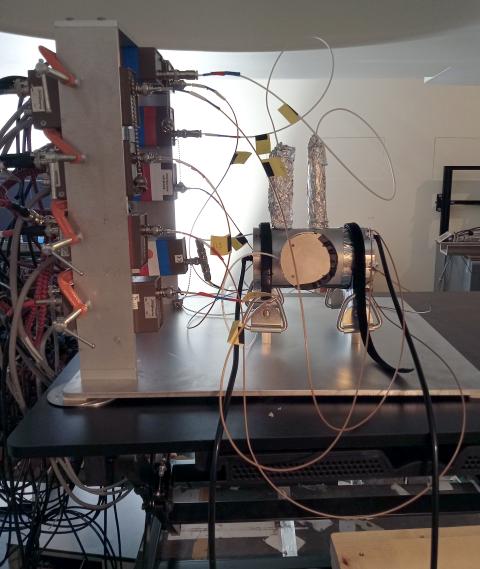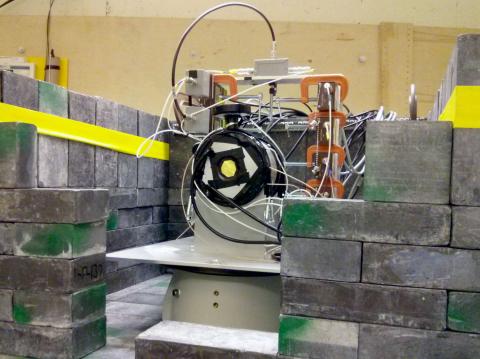
About Us
Our work involves the study of moderate- and high-energy particle radiation in space, mainly using space-based instruments. Particle energies are typically in the range ~0.5 MeV to ~10,000 MeV. The particles consist of all known stable element nuclei and electrons, but are dominated by protons and electrons, followed by helium, and then, to a much lesser number, all of the heavy ion nuclei (such as carbon or iron). There are four sources for these moderate energy particles: galactic cosmic rays, anomalous components, solar energetic particle events and planetary magnetospheres.
The space radiation we study also has Space Weather implications. These radiations contribute significantly to the radiation expose for humans in space, particularly beyond the Earthʼs magnetosphere (e.g., on missions to the Earthʼs moon and beyond) or in high-inclination Earth orbits where the Earthʼs magnetic field provides little protection over the poles. The latter even extends to aircraft on polar flights. These radiations also effect electronics in space. Total ionizing doses degrade electronics (including solar power cells) over time. Single Event Effects (SEE) in electronics are another serious aspect where a single energetic particle can cause a gate to flip (say in RAM), or latch or even burn out. It is believed that spacecraft have even been lost to particularly unlucky SEE events.
Studies of these particles look at both temporal and spatial variations, their energy and momentum spectra, elemental and isotopic composition, and inferred ionic charge state distributions. Correlations between events occurring on the Sun with changes in these particles’ properties often point to methods of particle acceleration in and transport through space plasmas.
Our research is mostly experimentally driven, as one of our main tasks is to design, build, and test new and innovative measurement techniques and new instruments, including space-based instruments such as those on GOES-16, -17, -18 and -19, to study these particles.
Galactic cosmic rays are stripped atoms permeating the galaxy, and are thought to be accelerated (for the most part) by shocks associated with supernovae remnants.
Anomalous components are neutral atoms in the local interstellar medium which penetrate the Heliosphere, become ionized (usually singly) in the inner Heliosphere, through either charge exchange with the solar wind or by ultraviolet photoionization, are picked up the solar wind and finally reaccelerated at the solar wind termination shock at ~100 AU from the Sun.
Solar energetic particles are charged particles that are either accelerated in the Sun’s lower corona and associated with solar flares, or accelerated at traveling interplanetary shocks driven by coronal mass ejections emitted from the Sun (also often associated with solar flares).
The largest source of Heliospheric particles coming from planetary magnetospheres are electrons accelerated in the magnetosphere of Jupiter, which then escape into interplanetary space. When just outside the Earth’s magnetosphere, because of its proximity, the Earth is also a significant source of planetary energetic particles.
Faculty
Jim Connell
Cliff Lopate

EHIS Instruments on GOES-R
Our current project is to enhance the data products from the Energetic Heavy Ion Sensor (EHIS) instruments we provided for the R-series of Geostationary Operational Environment Satellites (GOES-R). Four EHIS instruments are now in space on GOES-16, -17, -18, and -19. The latter two are active, with the first two in standby. These enhanced data products will have value for scientific research as well as space weather applications such as human dosimetry. They will also be archived at NASA.

The Diamond Cherenkov Telescope
In 2018 we started the development of a new application of a well-tested high-energy particle detection technique, that of measuring Cherenkov light emitted by particles traveling through different materials. Current improvements in the manufacture of man-made diamonds (high purity and acceptable cost) have allowed us to test diamonds as an alternate Cherenkov radiator for the measurement of energetic particles in space. We built and tested a proof-of-concept telescope at an accelerator and are currently seeking funding to continue development. This technique, combined with a plastic Cherenkov, would provide an unprecedented energy range of ~1-700 MeV in a single instrument, allowing it to replace the two or three instruments now needed for such measurements.

The PICAP Instrument
The Positron Identification by Coincident Annihilation Photons (PICAP) project is complete. This instrument is the first instrument specifically designed to measure and characterize positrons (anti-matter electrons) of energies ~1-50 MeV in space. A prototype was tested at accelerators to show it ability to reject protons with high efficiency and to determine the positron fraction even in the presence of a large gamma-ray background.

Instruments on Pioneer, IMP, CRRES, and ISPM
Our group has in the past been involved with instruments on the Pioneer-10 and Pioneer-11 deep space probes – now traveling out of the Heliosphere; the Interplanetary Monitoring Platforms IMP-7 and IMP-8, high Earth orbiters; the Combined Release and Radiation Effects Satellite (CRRES), a low-Earth orbiter; and the Ulysses International Solar-Polar Mission (ISPM) – the only man-made spacecraft to orbit the Sun perpendicular to the plane of the ecliptic. We have also run ground-based neutron monitors at Climax, CO and Haleakala, HI.